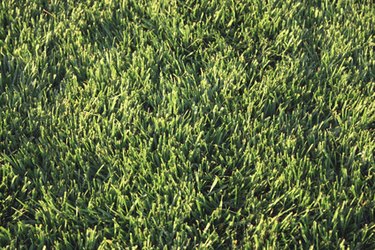
Simply sprinkling lawn seed on top of the dirt bed is not the ideal seeding method. When it comes to lawns, haste makes waste, and your effort to have a lawn in time for that summer cookout will backfire. Some seeds sprout despite harsh treatment, but seeding your lawn correctly prevents months of fertilizing, sweating and swearing over a struggling, weed-infested lawn. You'll have a thick, healthy lawn perfect for that Labor Day barbecue.
Germination
Video of the Day

Grass seed requires direct contact with the soil to germinate well. This firm contact surrounds the seed with necessary moisture and allows strong root development. While seed on the soil's surface may sprout, the unfriendly conditions stifle the germination rate, wasting your investment. Sun and wind also dry both the dirt and the poorly rooted seedling. In fact, pre-emergent herbicides function this way. The herbicide's chemical barrier prevents root growth, and the dehydrated seedling perishes.
Video of the Day
Seeding Procedures
Kentucky bluegrass, fescue and other cool-season grasses grow well in fall temperatures. These same cool temperatures put a halt to warm-season weeds like crabgrass, giving your seed time to establish without competition. Use a rotary or drop spreader to sow half the grass seed from north to south, and apply the second half from east to west. Rake in the seed lightly to a depth of 1/4 inch, and use a lawn roller to press the seed firmly into the soil.
Soil Preparation

The thickest, lushest lawns begin long before the seed touches the ground. Correcting soil problems before seeding is much easier and more effective than attempting to fertilize your way out of a poor lawn bed. Test your soil, add missing nutrients and incorporate aged compost or other organic matter into clay or sandy soils. Work the necessary amendments into the first 4 to 6 inches of the bed, and water well to settle it.
After Planting
Keep the seeded bed moist, even if it means lightly sprinkling the bed 3 to 5 times per day. Grass seed requires moisture to germinate, and dry beds kill newly emerging seedlings. As the seedlings grow, increase the amount of water and decrease the number of waterings, soaking the growing root zone. Lightly fertilize the lawn six to eight weeks after germination.